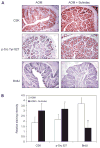Antiproliferative effect of sulindac in colonic neoplasia prevention: role of COOH-terminal Src kinase
- PMID: 18644992
- PMCID: PMC2493571
- DOI: 10.1158/1535-7163.MCT-08-0022
Antiproliferative effect of sulindac in colonic neoplasia prevention: role of COOH-terminal Src kinase
Abstract
Although the nonsteroidal anti-inflammatory drugs (NSAID) protection against colorectal cancer is well established, the molecular mechanisms remain unclear. We show herein that induction of the tumor suppressor gene COOH-terminal Src kinase (Csk) by NSAID is important for their antiproliferative and hence chemopreventive effects. In the azoxymethane-treated rat model of experimental colon carcinogenesis, sulindac treatment markedly induced Csk with a corresponding increase in inhibitory phosphorylation of Src (Tyr(527)). Sulindac-mediated Csk induction was replicated in the human colorectal cancer cell line HT-29, with a corresponding suppression of both Src kinase activity (63% of vehicle; P < 0.05) and E-cadherin tyrosine phosphorylation (an in vivo Src target). To determine the importance of Csk in NSAID antiproliferative activity, we stably transfected a Csk-specific short hairpin RNA (shRNA) vector into HT-29 cells, thereby blunting the sulindac-mediated Csk induction. These transfectants were significantly less responsive to the antiproliferative effect of sulindac sulfide (suppression of proliferating cell nuclear antigen was 21 +/- 2.3% in transfectants versus 45 +/- 4.23% in wild-type cells), with a corresponding mitigation of the sulindac-mediated G(1)-S-phase arrest (S-phase cells 48 +/- 3.6% versus 14 +/- 2.8% of vehicle respectively). Importantly, the Csk shRNA cells had a marked decrease in the cyclin-dependent kinase inhibitor p21(cip/waf1), a critical regulator of G(1)-S-phase progression (49% of wild-type cells). Moreover, although sulindac-mediated induction of p21(cip/waf1) was 113% in wild-type HT-29, this induction was alleviated in the Csk shRNA transfectants (65% induction; P < 0.01). Thus, this is the first demonstration that the antiproliferative activity of NSAID is modulated, at least partly, through the Csk/Src axis.
Conflict of interest statement
Disclosure of Potential Conflicts of Interest
No potential conflicts of interest were disclosed.
Figures






Similar articles
-
Involvement of p21cip1/waf1 in the anti-proliferative effects of polyethylene glycol in colon carcinogenesis.Int J Oncol. 2011 Feb;38(2):529-36. doi: 10.3892/ijo.2010.875. Epub 2010 Dec 17. Int J Oncol. 2011. PMID: 21170505
-
Down-regulation of the tumor suppressor gene C-terminal Src kinase: an early event during premalignant colonic epithelial hyperproliferation.FEBS Lett. 2005 Jul 4;579(17):3497-502. doi: 10.1016/j.febslet.2005.05.030. FEBS Lett. 2005. PMID: 15961079
-
Beta-escin inhibits colonic aberrant crypt foci formation in rats and regulates the cell cycle growth by inducing p21(waf1/cip1) in colon cancer cells.Mol Cancer Ther. 2006 Jun;5(6):1459-66. doi: 10.1158/1535-7163.MCT-05-0495. Mol Cancer Ther. 2006. PMID: 16818504
-
Sulindac sulfide inhibits epidermal growth factor-induced phosphorylation of extracellular-regulated kinase 1/2 and Bad in human colon cancer cells.Cancer Res. 2003 Feb 1;63(3):616-20. Cancer Res. 2003. PMID: 12566304
-
Inhibition of extracellular signal-regulated kinase 1/2 phosphorylation and induction of apoptosis by sulindac metabolites.Cancer Res. 2001 Feb 15;61(4):1541-7. Cancer Res. 2001. PMID: 11245463
Cited by
-
COX-Independent Mechanisms of Cancer Chemoprevention by Anti-Inflammatory Drugs.Front Oncol. 2013 Jul 11;3:181. doi: 10.3389/fonc.2013.00181. eCollection 2013. Front Oncol. 2013. PMID: 23875171 Free PMC article.
-
Neo-angiogenesis and the premalignant micro-circulatory augmentation of early colon carcinogenesis.Cancer Lett. 2011 Jul 28;306(2):205-13. doi: 10.1016/j.canlet.2011.03.008. Epub 2011 Apr 14. Cancer Lett. 2011. PMID: 21493000 Free PMC article.
-
Nano-architectural alterations in mucus layer fecal colonocytes in field carcinogenesis: potential for screening.Cancer Prev Res (Phila). 2013 Oct;6(10):1111-9. doi: 10.1158/1940-6207.CAPR-13-0138. Epub 2013 Aug 27. Cancer Prev Res (Phila). 2013. PMID: 23983085 Free PMC article.
-
HDAC up-regulation in early colon field carcinogenesis is involved in cell tumorigenicity through regulation of chromatin structure.PLoS One. 2013 May 28;8(5):e64600. doi: 10.1371/journal.pone.0064600. Print 2013. PLoS One. 2013. PMID: 23724067 Free PMC article.
-
Nonsteroidal anti-inflammatory drug sulindac sulfide suppresses structural protein Nesprin-2 expression in colorectal cancer cells.Biochim Biophys Acta. 2014 Jan;1840(1):322-31. doi: 10.1016/j.bbagen.2013.09.032. Epub 2013 Sep 27. Biochim Biophys Acta. 2014. PMID: 24080406 Free PMC article.
References
-
- Jemal A, Siegel R, Ward E, Murray T, Xu J, Thun MJ. Cancer statistics, 2007. CA Cancer J Clin. 2007;57:43– 66. - PubMed
-
- Rao CV, Reddy BS. NSAIDs and chemoprevention. Curr Cancer Drug Targets. 2004;4:29– 42. - PubMed
-
- Bresalier RS, Sandler RS, Quan H, et al. Cardiovascular events associated with rofecoxib in a colorectal adenoma chemoprevention trial. N Engl J Med. 2005;352:1092–102. - PubMed
-
- Dube C, Rostom A, Lewin G, et al. The use of aspirin for primary prevention of colorectal cancer: a systematic review prepared for the U.S. Preventive Services Task Force. Ann Intern Med. 2007;146:365–75. - PubMed
-
- Kashfi K, Rigas B. Non-COX-2 targets and cancer: expanding the molecular target repertoire of chemoprevention. Biochem Pharmacol. 2005;70:969– 86. - PubMed
Publication types
MeSH terms
Substances
Grants and funding
LinkOut - more resources
Full Text Sources
Miscellaneous

